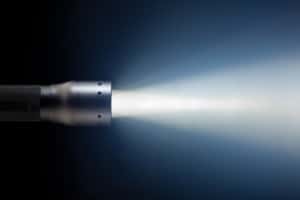LEDs are bright. They offer a powerful light that will brighten any night. It’s also a rather inexpensive technology, so you can pick up a great LED flashlight at a great price today. But how does an LED flashlight work?
It all begins with the diode technology that is the foundation of the LED. Diodes are devices that are able to conduct an electrical current in just one direction. This is one of the primary differences between LEDs and incandescent bulbs since a bulb works with current flowing either way through it.
LEDs are also composed of semiconductors, which give this technology an ability to vary the current of electricity. When an electrical current is applied to the diode, then the electrons travel to the two semiconductors that are in a standard LED. When the electrons fall into the semiconductor, they release energy in the form of photons.
And photons are particles of light.
Providing Power to an LED Flashlight
In order for electrons to be produced, a flashlight must have some type of power source. There are three primary sources of power that are provided to the modern LED flashlight.
- Alkaline batteries.
- Rechargeable batteries.
- Hand-crank power.
Each type of power source has certain advantages to it. Alkaline batteries are highly affordable, for example, and can provide a full charge based on the manufacturer’s power consumption rating. Most flashlights will last 4-10 hours on a set of alkaline batteries.
Rechargeable batteries are more expensive, but they also provide more light and can be used 500+ times in some situations. Look for true 18650 rechargeable batteries for the best results in this category.
Sometimes you don’t have access to alkaline batteries or a power source to recharge your lithium-ion battery. In that emergency situation, the hand-crank flashlight is the best option as a power source. It takes 1-2 minutes of winding to receive 1-2 hours of stored energy for the flashlight to use. Many emergency flashlights also have a radio equipped to them as an additional benefit.
How Can LEDs Offer Light in Different Colors?
The color of light is due to a specific wavelength. By altering the wavelength just a little, an LED can be manufactured to produce different colors other than white. The composition of the semiconductors used for the LED will help to dictate the final color of light that is produced.
For example: to obtain a red light from an LED, a semiconductor that uses aluminum gallium arsenide would be used. Green LEDs use a phosphide and blue LEDs use a nitride. White LEDs are made by combining different colors, including yellow. That’s why some LED flashlights have been equipped with yellow phosphor coatings. It improves the overall quality of the light that can be produced.
For most people, a flashlight is just another light they can use. When you know how an LED flashlight works, it does become easier to understand what maintenance and repairs may be needed over time to keep the flashlight working in a pristine condition. That may not be important for a flashlight in the $10-$30 price range, but for flashlights in the $200-$500 range?
That’s knowledge that can save you cash.















